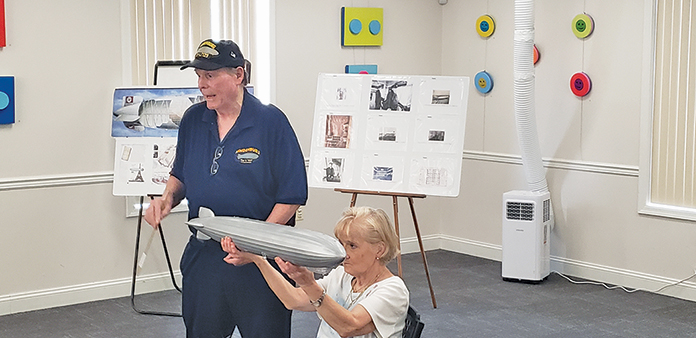MANCHESTER – It may have occurred 88 years ago, but the tragic and historic loss of the airship Hindenburg is still capturing the interest and imagination of area residents.
A presentation about the ill-fated aircraft was given at the Manchester branch of the Ocean County Library on the anniversary of its crash on May 6.
One of many questions that are asked about the noted airship is how it got its name. That was one of many gems of information that township resident Bill Schmidt provided in his second anniversary program.
Schmidt’s program detailed the tragic events that occurred on May 6, 1937. The flight of which began on May 3 of that year and the incident occurred around 7 p.m. on May 6. He called on the audience to imagine themselves being part of that ill-fated flight and purchasing tickets. He walked them through what they would have to do, what they would see and the general atmosphere of that time period.
Along with display boards, a PowerPoint presentation coordinated by his assistant Gerald Weaber Jr., a few books that were passed out to the audience to browse through, Schmidt brought along a model of the Hindenburg which he had a volunteer from the audience hold as he pointed out various sections of the airship.
He explained how several of the German airship fleet were referenced as “Grand Zeppelins” and that came from “a guy named Count Ferdinand von Zeppelin. He is the inventory of the zeppelins that we are about to talk about.”
“He started what was called the Zeppelin Corporation. When you design something, you have the right to name the product whatever you wish,” Schmidt said. “They were called zeppelins after him.”
Manchester resident Bill Schmidt speaks about the tragic events of the Hindenburg as a member of the audience holds up a model of the historic airship during a program held at the Manchester Library. (Photo by Bob Vosseller)
As to why airship 129 wasn’t called a zeppelin, the Navy veteran explained “it would have been called a Grand Zeppelin except for Paul von Hindenburg, a famous World War I general. Even though Germany didn’t win the war, he won a lot of battles.”
“Once the war was over, he came back to Germany and the people said to him, we want you to be our chancellor which also means president,” Schmidt said. “He became president of Germany from about 1918 until around 1932 -33. When Adolph Hitler came along and wasn’t the Fuhrer yet, he asked him to remove himself from office so he could take the office over.”
Schmidt added that the request was made by Hitler’s staff in such a manner that Hindenburg was told “if you don’t, he is liable to hang or shoot you to get you out of the way. So Paul being a level headed guy said okay, I’ll leave. He’d been there long enough anyway.”
“So, Hitler came to power and out of respect for Paul to leave the position without having to be killed he decided to call airship 129 the Hindenburg and that is how the Hindenburg got its name.”
As was the case last year, Schmidt’s program was well attended with most seats taken in the meeting room of the library. Among those who came out were Sandra Carlisle and Jeanne Stein of Holiday City in Toms River.
“I remember watching something on a TV special and my friend had asked me if I wanted to join her to come to this tonight. I remember when it happened. I didn’t remember the year it happened so I came out to refresh my memory and maybe hear more information about it that I didn’t previously know,” Carlisle said.
She added, “as I got older, I got more interested in travel and learning more about the different things that have happened in history.”
Faye Geiser said she came out as part of a group in the Whiting section of Manchester and also in Toms River. Geiser said she was a volunteer of the America’s Keswick which is a Christian Conference Center (in Whiting) and had learned that the grandson of the originator of Keswick’s had been brought to see the Hindenburg when it burned. “I think he was 9 years old at the time.”
The airship disaster put Lakehurst Borough on the map to the point that a dirigible graphic was incorporated into the symbol of the borough, but as Schmidt noted, the property where the crash took place was technically in Manchester.
Schmidt conducted two presentations at county library branches that day but Manchester’s was symbolic to the time period of which the fiery explosion occurred nearly a century ago at the Lakehurst Naval base.
The post Hindenburg Program Notes How Historic Airship Got Its Name appeared first on Jersey Shore Online.


